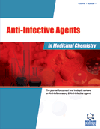-
oa Unique Applications of Novel Antifungal Drug Combinations
- Source: Anti-Infective Agents in Medicinal Chemistry (Formerly Current Medicinal Chemistry - Anti-Infective Agents), Volume 6, Issue 1, Jan 2007, p. 3 - 15
-
- 01 Jan 2007
Abstract
Candida albicans is a commensal fungal organism that can over-proliferate and cause disease in the appropriate host setting. C. albicans can cause irritating superficial skin and mucocutaneous infections such as diaper rash and vaginal yeast infections, respectively. In immunocompromised hosts, these infections can progress to disseminated disease in which the organism enters the blood and colonizes multiple organs. Consequently, Candida infections result in a considerable amount of morbidity and mortality every year. Most modern-day antifungal drugs block ergosterol biosynthesis. Several of these agents are fungistatic and do not kill the fungal cell, thus facilitating the emergence of drugresistant species, which further complicate therapy. Alternatively, some of the most effective antifungal drugs are too toxic for continuous use or can only be administered intravenously. The ideal antifungal drug would be non-toxic, fungicidal, and amenable to self-administration. Previous studies have demonstrated that specific commercially available drugs from two unrelated drug classes (calcineurin inhibitors and ergosterol biosynthesis inhibitors) act synergistically to kill Candida by targeting distinct molecular pathways in the organism. Calcineurin inhibitors are immunosuppressive agents, so systemic administration of these drugs would be counter-intuitive for treatment of already immunocompromised individuals. However, this drug combination can be applied to topical antifungal therapies for a variety of cutaneous and mucocutaneous fungal infections that afflict a diverse population, including immunocompromised patients.


